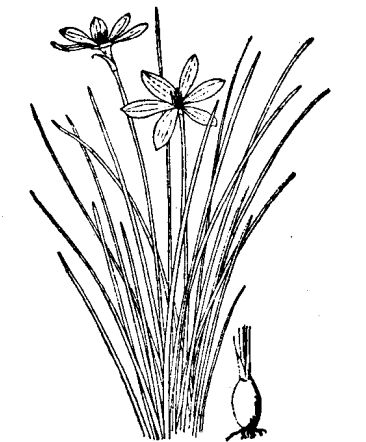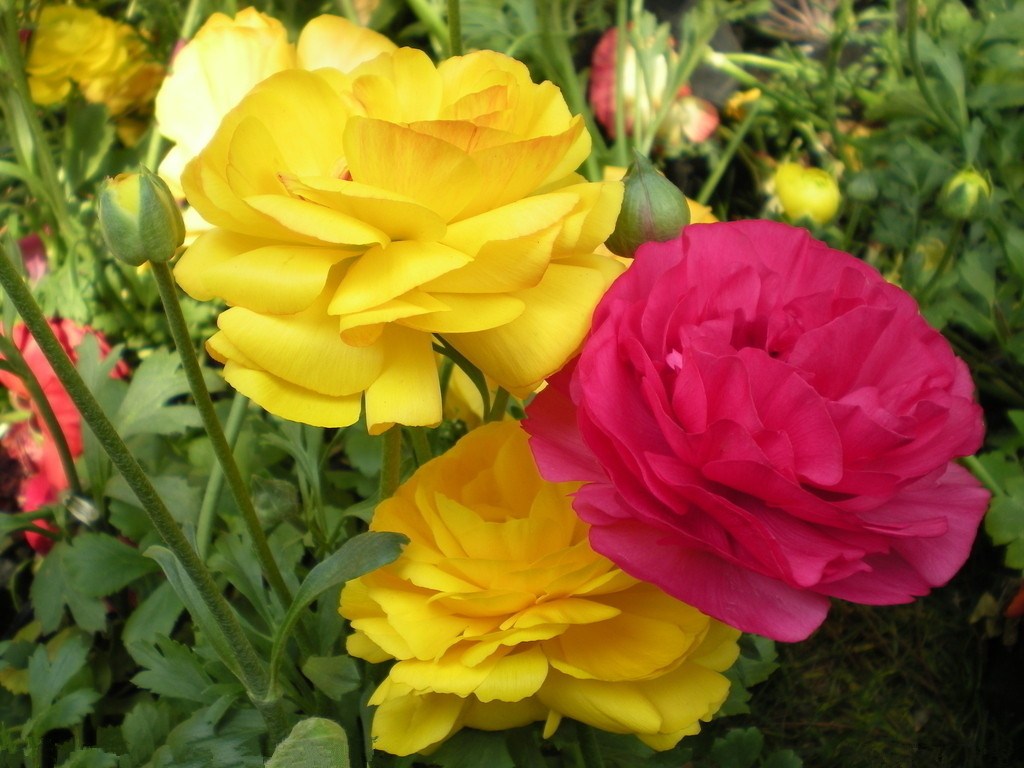Cultivation and producing area distribution of onion orchid
[alias] onion lotus, jade curtain, white gladiolus lotus.
[family genus] Amaryllidaceae, Allium.
Perennial evergreen herbs, with small and slender bulbs at the neck, 15-20 cm tall. Leaves basal, linear, slightly fleshy, dark green. Scape hollow, 10 mm tall, enclosed in maroon membranous bracts, drawn from one side of leaf clusters; flowers solitary, white or slightly purplish halo, tepals 6, elliptic-lanceolate, without tube; flower diam. 3 min. 4 cm. Flowering period from late July to early November. Capsule triangular-globose, loculicidal at maturity.
[Origin and distribution] originated in South America.
[habits] like sunny, well-drained, fertile and slightly clayey soil, but also resistant to semi-shade and low humidity environment. It is hardy and can survive the winter in the open field in Shanghai and Hangzhou.
[reproduction] when planting seed balls in spring, it is appropriate to plant 3-4 holes in one place.
[cultivation] strong growth, simple and extensive management, planting a place can be dug once a few years, without more management.

[purpose] low and neat bushes, numerous flowers, long flowering period and strong sex, it is most suitable for cover plants under forests and slopes, as well as edge materials for flower beds, flower borders and roadsides, or potted ornamental plants.
[attached: also belong to other flowers] leek lotus (Zephyranthesgrand1fl0raL1ndl.): also known as red jade curtain, calamus lotus, wind and rain flowers. The bulb is rounded, slightly larger than the previous species. Leaves flat and linear. Bracts red, flowers funnel-shaped, with tube, perianth lobes Obovate, pink or rose; flowers also larger than previous species, 5-7 cm in diameter. Florescence from the middle of June to the end of September. Originally from Mexico, Cuba and other places. Habits, cultivation and management are the same as onion orchid. Except for the good microclimate, it is difficult to survive the winter in the open field in Shanghai, except for its poor cold resistance.
Cultivation of onion orchid
Scientific name: Zephyranthes Candida alias: green onion lotus, jade curtain, gladiolus lotus origin: South American morphological characteristics: perennial evergreen vegetation. With small and slender bulbs at the neck. Leaves basal, linear, slightly fleshy, bright green. The flowering stem is drawn from one side of the foliage and the terminal flower is 1. White or slightly purplish red. The seeds are black and flat. The florescence is from July to November. Biological characteristics of Amaryllidaceae, Allium. Like warm, moist and light, but also resistant to semi-overcast and low humidity. Require good drainage, fertile and slightly clayey soil. Culture: green onion orchid is mainly farmed by dividing balls and sowing seeds. Bulbs: in spring, 3 Murray and 4 bulbs are planted in each hole. Sowing: in spring, the seeds collected in last summer and autumn were sown in the seedbed and germinated in 20 days, with a higher germination rate. Cultivation: the planting density is 6090 plants per square meter. Like warm, moist and sunny, but also resistant to semi-overcast and moisture. Well-drained, fertile and slightly clayey soil is required. Green onion orchid has strong growth and extensive maintenance and management. After a few years of planting, it can be dug up and planted separately to promote growth and breeding. Rotten leaves can be used as base fertilizer and liquid fertilizer is applied every semimonthly. During the peak growth period, watering and topdressing should be appropriate according to the seedling potential. The green onion lotus likes sufficient sunlight, and the quality of the seed ball obtained in shade environment is poor. Just keep the environment properly ventilated. The suitable temperature for the growth of onion lotus is 16-28 ℃, it is not cold-resistant, and the overwintering temperature should not be lower than 5 ℃. Bulbs in cold areas can not overwinter in the open field. Bulbs should be collected before winter, dried slightly, mixed with moist fine sand and stored in a kiln. It should be replanted after several years of cultivation to promote its growth. During the peak growing season, watering and topdressing should be appropriate according to the growth trend. The bulbs can be dug up and stored in winter. Maintenance management is extensive. Green onion orchids can also be planted in water tanks to produce bright leaves. In August, the plant height has reached more than 30 centimeters, when dozens of flower stems can be drawn, and white flowers will bloom in late September. It is commendable that these flowers are located below the surface of the water, through the bright water, set off the crystal white, high and low scattered onion orchid. The specific way to raise onion orchids in water is to prepare several glass fish tanks that are 90 centimeters long, 50 centimeters high and 35 centimeters wide. In early April, in an oblong or round white plastic bag or shallow porcelain basin with a height of 4 cm to 5 cm, the bulbs of onion orchid were laid out according to the plant spacing of 2 cm to 3 cm. The root system should be stretched, the root should be pressed with clay, and the soil should be filled to level with the upper part of the bulb. After planting, sink the basin in the sink or pool, gently swing from side to side, wash away the floating mud on the surface, and put it into the fish tank filled with water. The water in the fish tank should not be too full, and it is advisable to use the high 4-stroke-5 tank. In order to increase interest, you can also keep some small tropical fish in the tank.
. Key points of cultivation and management of onion orchid
Many friends may hear the name of onion orchid and think it is orchid (details). In fact, onion orchid is a perennial herb of Amaryllidaceae, which has nothing to do with Orchidaceae. Green onion orchids are very common in our daily life, and they are often seen in flower beds and roadsides.
Green onion orchid
Onion orchid is used for ground cover plants, or for flower beds, lace, under the forest, but also for pot cultivation and extensive management. Green onion orchid, like fertile soil, resistant to semi-shade or low temperature environment. The main methods are ramet and sowing, but in order to blossom in the second half of spring planting, separate planting bulbs have the greatest grasp. Onion orchid is easy to divide balls naturally and propagate easily. Cultivation in Huang-Huai area should pay attention to proper protection against cold in winter.
Onion orchid should be well watered during the growth period, and the basin soil should be kept moist, but not stagnant water. When the weather is dry, water is often sprayed on the leaves to increase air humidity, otherwise the leaf tips are easy to yellow and wither. There are more requirements for fertilizer and water, but they are most afraid of random fertilization, concentrated fertilizer and partial application of nitrogen, phosphorus and potash fertilizer, and are required to follow the two principles of fertilization and water application: "less fertilizer, more light fertilizer, more frequent application of light fertilizer, complete nutrition" and "dry and wet, dry, dry and not watered." after fertilization, leaves and flowers should be kept dry at night.
Bulbs in cold areas can not overwinter in the open field. Bulbs should be collected before winter, dried slightly, mixed with moist fine sand and stored in a kiln. It should be replanted after several years of cultivation to promote its growth. During the peak growing season, watering and topdressing should be appropriate according to the growth trend. The bulbs can be dug up and stored in winter. Maintenance management is extensive. Green onion orchids can also be planted in water tanks to produce bright leaves. In August, the plant height has reached more than 30 centimeters, when dozens of flower stems can be drawn, and white flowers will bloom in late September.
- Prev

How to manage the rose to blossom more?
To make potted rose blossom more, there are three conditions, that is, light, fat and diligent hands. With these three conditions, the rose is easy to raise and the rose can blossom more. The following three requirements are specified for your reference. 1. The sunshine time is longer. Rose is a positive flower, potted rose should have at least 5 hours of light every day.
- Next

The habit, Origin and Distribution of Iris
[alias] Phalaenopsis, Phalaenopsis, iron pole. Iridaceae, Iris. [morphology] the rhizome is short, thick and jointed. The plant height is 3060 cm. The leaf is sword-shaped, 30 meters long, 50 centimeters long and 2.5 centimeters wide. Flowering stem 30-50 cm tall, with 1 Murray 2 branches
Related
- Fuxing push coffee new agricultural production and marketing class: lack of small-scale processing plants
- Jujube rice field leisure farm deep ploughing Yilan for five years to create a space for organic food and play
- Nongyu Farm-A trial of organic papaya for brave women with advanced technology
- Four points for attention in the prevention and control of diseases and insect pests of edible fungi
- How to add nutrient solution to Edible Fungi
- Is there any good way to control edible fungus mites?
- Open Inoculation Technology of Edible Fungi
- Is there any clever way to use fertilizer for edible fungus in winter?
- What agents are used to kill the pathogens of edible fungi in the mushroom shed?
- Rapid drying of Edible Fungi

